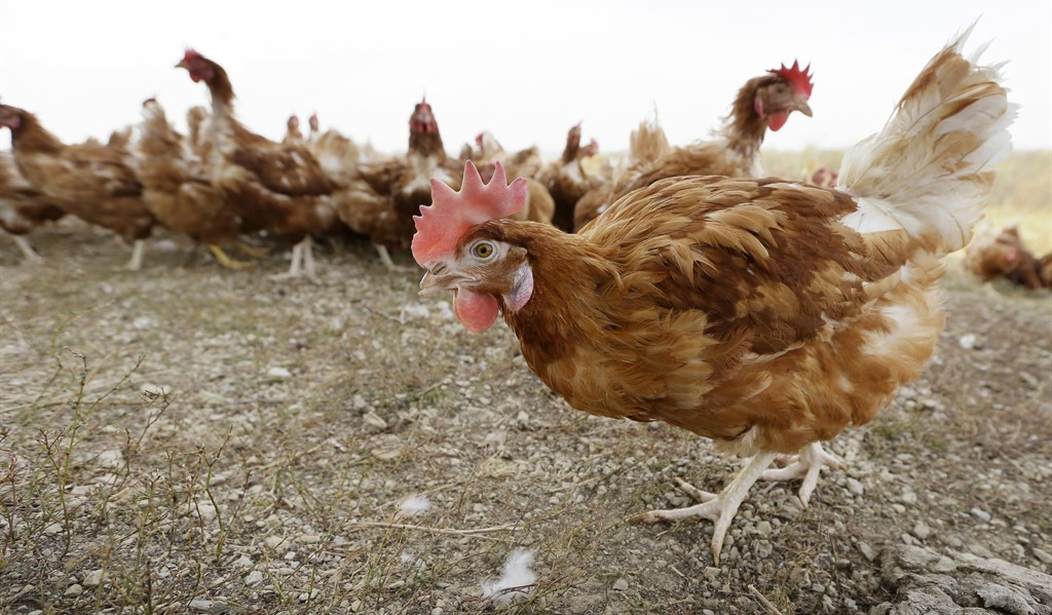The steadily rising price of a dozen eggs at your favorite supermarket is just about all you need to know. There are big problems in the domestic poultry industry.
When the price recently jumped to $5 a dozen, it signaled another outbreak of the bird flu.
The bird-flu (highly pathogenic form of avian influenza) outbreaks are wreaking havoc on laying flocks of leghorns (white eggs) and Rhode Island reds (brown eggs) after being exposed to the virus introduced by wild birds (migratory ducks and geese passing it on to resident birds and then to the hen houses).
Newsmax recently posted an article describing how the TypeA H5N1 influenza virus, generally believed not to pose a direct threat to humans, may in fact be on the cusp of mutating to a more virulent form that could threaten a new pandemic that might turn out even worse than COVID-19. For this to occur, the virus would first need to break through the interspecies transmission barrier that has so far prevented direct transmission from birds to humans.
My recollection from earlier days as a 4-H Club member, who raised chickens, was no disease like a bird flu existed at that time. There were a number of other poultry diseases, coccidiosis (protozoan agent) and New Castle disease (virus) that were effectively medicated or prevented with vaccination.
Left unvaccinated or untreated, these diseases and several other kinds would ravage the unprotected flock, as duly warned by our county extension agents.
A case of bird flu does not necessarily result in the death of an individual bird, but will impair its health to such degree that it never recovers to productivity.
Recommended
The only option left is to kill the entire flock that may number a million birds, then clean and sterilize the facility before beginning anew with a fresh flock of chicks. It may require four to five months for a newly hatched chick to mature into a novice layer (pullet).
The small eggs obtained during the first few months are not readily marketable as the familiar grade-A large eggs most consumers prefer. The maturation time imposes even further delays to the time required to rehabilitate a profitable egg producing facility.
The repeated, severe outbreaks of avian flu recurring during the past few decades roil the egg market. And despite vaccines that have existed for other poultry and livestock diseases, there is still no FDA-approved vaccine that confers immunity to the avian flu.
Anticipated mutations in the H5N1 virus may allow it to cross the interspecies barrier directly into humans.
In this regard there has been, to my knowledge, no concerted effort to bring to market an antiviral product capable of defeating the H5N1 virus responsible for the debilitating disease in poultry or livestock.
Now with credible prospects of the anticipated mutation in the H5N1 virus that may allow it to cross the barrier into humans, a sense of urgency is thrust into the discussion.
Never mind the sky-high price of eggs at Kroger. There may be far more at stake here than paying $5 or more for a dozen grade-A eggs.
The long-approved practice of culling poultry flocks to stop the spread of viruses to nearby operations persists in today's poultry industry. It is in turn bolstered by the in-house thinking of allies in the federal government (USDA and FDA). Legitimate suspicion remains that there may be more afoot than the random possibility that some interests are benefitting--and handsomely—behind the curtains.
Follow the money, or qui bono, as the Romans once said. Higher prices redound to better profit margins up and down the industry.
I don't particularly relish being tagged as a conspiracy theorist. But far too many bird-flu outbreaks have hit the national scene for the story to be a mere random sequence of unfortunate events.
In prior decades repeating outbreaks of bird flu were not observed to happen, despite reports of its existence back into the late 19th Century.
Few veterinary issues have been more egregiously handled than the repeated outbreaks of bird flu during the past two decades.
The standard response from official Washington has been to call for summary culling (extirpation) of entire flocks of egg-laying chickens and roasting turkeys whenever the disease presents.
Yet, there are a number of other veterinary diseases long since successfully dealt with in the United States through proper medication and the use of vaccines: the previously mentioned New Castle disease and coccidiosis are two good examples that stand out among a dozen or so relatively common diseases that adversely affect poultry.
But for whatever reasons an effective vaccine for bird flu has not yet been approved by the FDA. It is not even clear that a serious research effort has been mounted to combat the disease through means like vaccination.
Thankfully for our dairy farmers, they are not being required to cull their herds if and when found infected with H5N1 virus. Most infected cows recover fully after an unpleasant fortnight of respiratory discomfort.
Notably, milk and cheese, if found to be contaminated with the virus, must be properly disposed before it enters the retail market.
We can take comfort in the knowledge that the H5N1 virus is not thermally stable. Pasteurization deactivates the virus if initially present in commercial milk.
In the mean-time, remember to cook your eggs well.
William D. Balgord, Ph.D. heads Environmental & Resources Technology, Inc. in Middleton, Wisc. He is a contributing writer for the Cornwall Alliance for the Stewardship of Creation.

























Join the conversation as a VIP Member